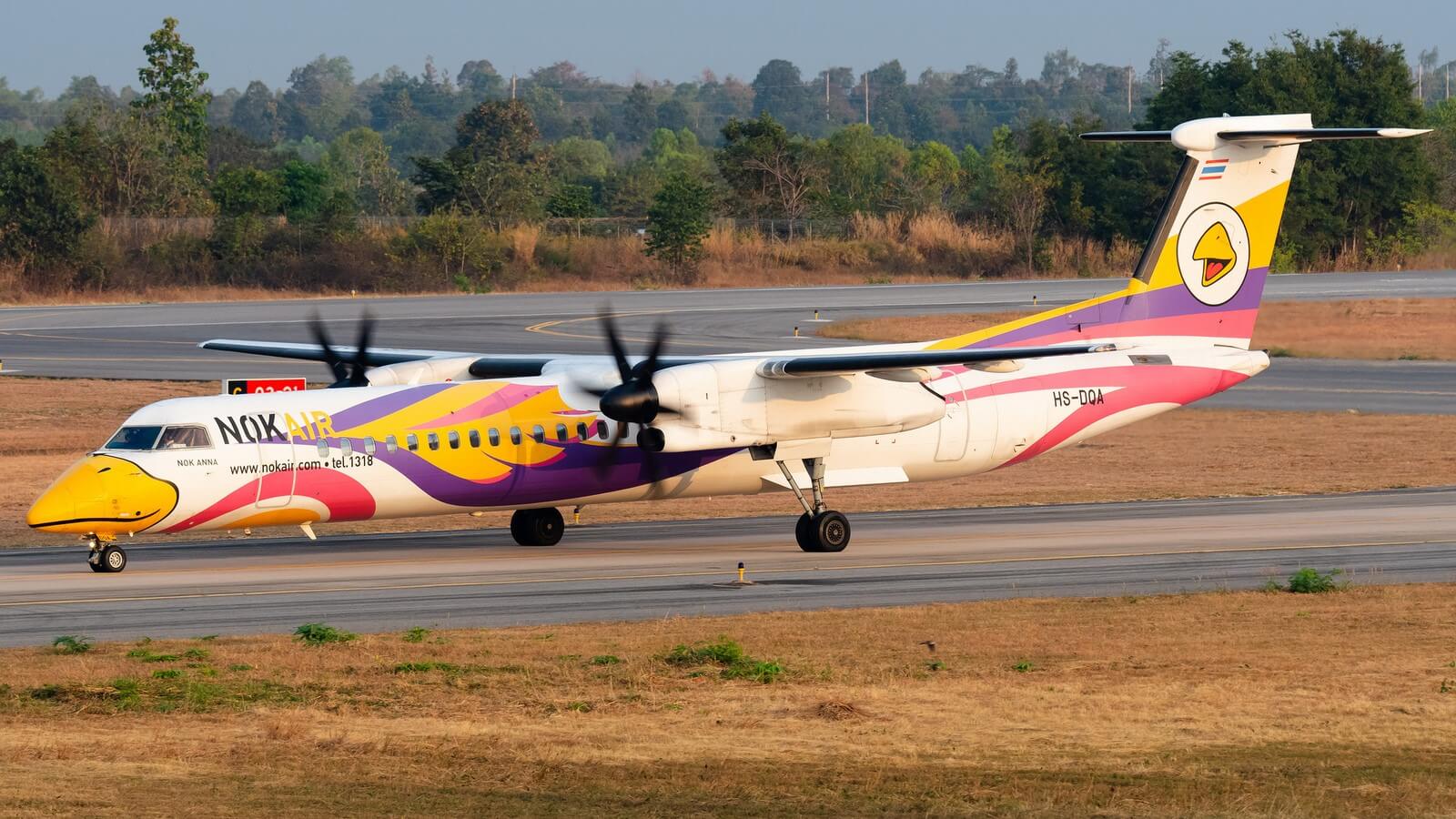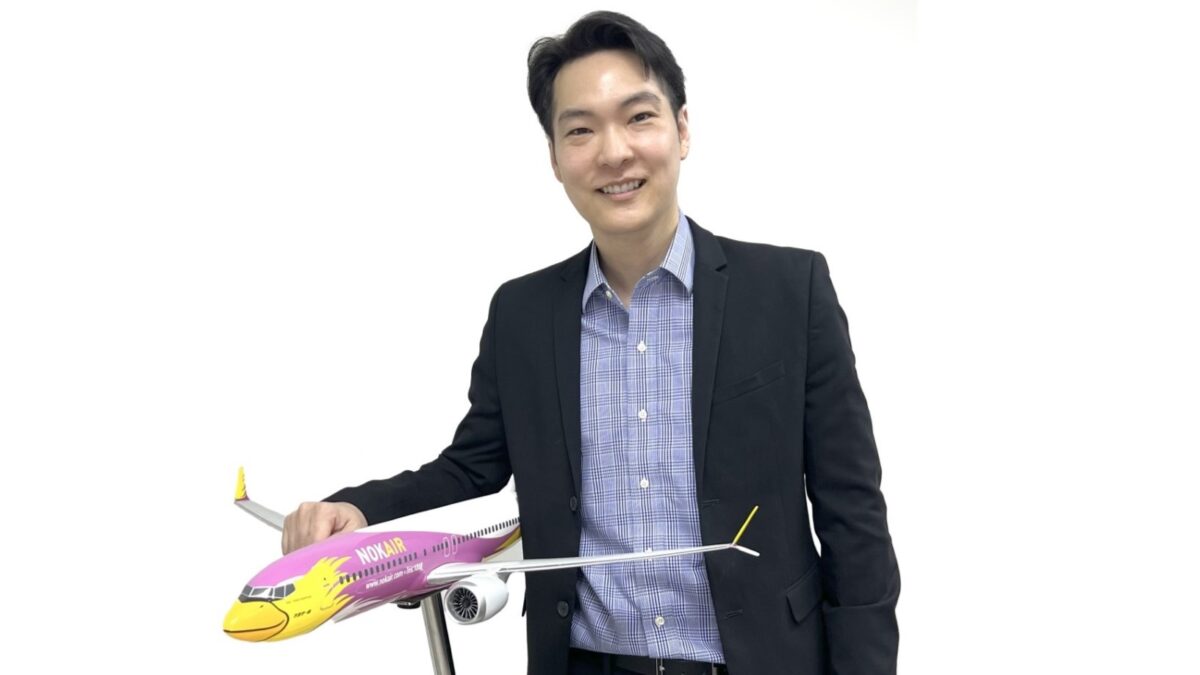Note: Thai language version of article is lower down หมายเหตุ: บทความภาษาไทยอยู่ด้านล่าง
Nok Air is spreading its wings to cash in on the air travel recovery triggered by the removal of COVID-induced entry curbs.
The Thai budget carrier, founded in 2004, is ramping up its operations by resuming its international flights, boosting domestic services and reconfirming its plan to add six Boeing 737-800s.
The the carrier is still working to restructure its five billion baht (US$143 million) debt, under a rehabilitation plan approved by the Thai court in September 2021. The carrier, however, says it has made some significant headway in its restructuring.
But higher jet fuel prices, which have doubled over the past six months or so to around US$170 per barrel, coupled with intensified fare competition among Thai airlines, is a challenge that could dampen Nok Air’s turnaround bid.
This, in a nutshell, is what Nok Air CEO, Wutthiphum Jurangkool, tells Smart Aviation Asia Pacific in an exclusive interview.
International resumption
Nok Air’s resumption of services to Thailand’s neighbouring states, suspended over the past few years, is beginning in earnest as countries in the region have eased rules and in-bound travel control measures.
Wutthiphum confirms the airline is resuming its Bangkok Don Mueang-Yangon service on 1 July, joining two Thai low-cost carriers – Thai Smile and Thai AirAsia – which resumed flights to the Myanmar city on 1 and 3 June respectively.
Nok Air will in mid-July restore Bangkok-Ho Chi Minh City services. Flights from Bangkok to Danang and Dalat in Vietnam will follow later this year.
India also features prominently on Nok Air’s radar screen for international resumption. The airline is working to secure traffic rights from India’s aviation authority to serve more than five Indian airports from Bangkok.
Wutthiphum says he hopes to receive the rights in one month from now, adding that the airline has appointed DEX Group as its general sales agent (GSA) in India.
Meanwhile, Nok Air is exploring synergistic opportunities with Thai Airways International and its subsidiary Thai Smiles to enhance its Indian coverage by means of interline and code-shares which may roll out by year-end, says Wutthiphum.
Thai Airways holds air traffic rights to India and has airport slots there that are only partially used, as a result of COVID-inflicted flight suspensions, but which Nok Air and Thai Smile could utilize.
India is seen as a stopgap market for Nok Air as the larger market of China remains closed due to that country’s zero COVID policy and related travel restrictions.
Wutthiphum says Nok Air hopes to re-start its China services with flights from Bangkok to Nanning, but that is subject to approval from China’s civil aviation authority. China has indicated recently that it may re-open the skies for Thai airlines on a very limited scale.
“There is a lot of unclearness and uncertainties about China [with regards to aviation policy relating to foreign carriers], and that is why we focus now more on India and finding other markets before China opens up,” he says.
Domestic expansion
Nok Air intends to ramp up frequencies on its 20-plus domestic routes so as to return to pre-COVID levels, says Wutthiphum.
The airline is examining two possible new routes: Nakhon Ratchasima-Chiang Mai and Bangkok-Khon Kaen.
He says launching flights from Nakhon Ratchasima may require support from the government and private sector to make the route viable. If it launches the service, it will use its De Havilland Aircraft of Canada Dash 8-400s, he adds.
The airline hopes to continue with its thrice-weekly Dash 8-400 service from Bangkok Don Mueang to Betong in the southernmost province of Yala, says Wutthiphum.
The airline started the service on 14 March, but it was suspended briefly, due to poor passenger loads, before resuming again when local tourism bodies agreed to support the service.
Wutthiphum says they will continue with the scheduled service until October, because the passenger load factor has soared to 90%, thanks to promotional support from the local tourism industry which has chipped in financially.
Thanks to the support, the carrier was able to reduce one-way fares on the route to as little as 3,000 baht (US$85).
Fleet enlargement
Wutthiphum says Nok Air operates three Dash 8-400s and plans to increase its Boeing 737-800 fleet to 20 from 14 later this year and in the course of next year. Nok Air has yet to decide whether to exercise its existing order, originally placed in 2014, for six Boeing 737 Max aircraft, he adds.
He also says Nok is content with having three Dash 8-400s, which is actually a reduction on the eight it had last year. Nok Air reduced the Dash 8 fleet in response to high lease and maintenance costs, he adds.

Nok Air De Havilland Aircraft of Canada Dash 8-400 (Source: Amarase Pamarapa)
Intensifying competition
Wutthiphum says increased fare competition in Thailand – at a time when fuel and other costs are spiralling – is making the market even tougher.
“Fares nowadays are not commensurate with spiking fuel prices and soaring costs, thus diminishing revenues and putting airlines deeper in the red,” he says, adding airlines are reluctant to increase fares as that would drive passengers away.
The average one-way domestic fare should be around 1,600 baht, but airlines are charging only about 1,200-1,300 baht, he says.
Thai carriers are unable to address this issue among each other as such move would be considered by regulators as illegal fare collusion.
Nok Air is advocating that Thai authorities set limits on how low air fares can go, arguing such a floor price is needed or else some airlines will be driven out of business, resulting in severe consequence for the country’s aviation and tourism industry, he states.
Soaring fuel prices
The government has reduced the excise imposed on jet fuel, but it is only a temporary measure that is due to expire end of this month. Wutthiphum is calling on the government to extend it to the end of this year, so as to help airlines weather rising fuel prices.
Local oil refiners should also help mitigate higher jet fuel prices by forgoing some of their gross refining margins, he adds.
Rehabilitation
Nok Air has fulfilled the requisites spelt out in the rehabilitation plan and has been paying its creditors regularly so as to pay off its debt, says Wutthiphum. Its main creditors are eight aircraft leasing companies.
“Though we are not out of the woods yet, the most critical stage is behind us,” he says, noting that the airline’s first-quarter financial results are far better than the previous period.
The airline’s situation has improved, says Wutthiphum, adding that the airline’s average passenger load factor is 70%, revenue is higher and it is now carrying nearly 10,000 passengers a day.
Though average fare prices, in US dollars terms, are below what the airline had targeted due to the depreciation of the Thai baht. He says Nok Air aims to breakeven this year and have four million passengers this year compared to just one million last year.
Featured Picture of Nok Air CEO Wutthiphum Jurangkool (Source: Nok Air)
Related Stories:
Thailand’s Nok Air Plans To Revive Betong International Airport Operations (15 April 2022)
Thailand’s Nok Air Announces Plan To Avoid Delisting From Stock Exchange (7 April 2022)
Nok Air Shuts Operations To Thailand’s Betong International Airport A Day After Inaugural Flight (18 March 2022)
Thailand’s Nok Air To Launch Services To Newly Opened Betong Airport (28 February 2022)
EXCLUSIVE INTERVIEW: Rehabilitation Gives A New Lease Of Life To Nok Air (4 November 2021)
Thailand’s Nok Air Planned to Replace some 737s with Dash 8s (13 March 2020)
นกแอร์ สยายปีกหลังหลังผ่านพ้นจุดต่ำสุดของปัญหา
นกแอร์ สยายปีกรับการการฟื้นตัวของการเดินทางทางอากาศ ตอบรับการยกเลิกมาตรการควบคุมการเข้าเมืองที่เกิดจากโควิด-19
สายการบินราคาประหยัดของไทยซึ่งก่อตั้งขึ้นในปี 2004 กำลังเร่งการดำเนินการ โดยกลับมาให้บริการเที่ยวบินระหว่างประเทศ ส่งเสริมบริการการบินภายในประเทศ และยืนยันแผนการที่จะจัดหาเครื่องบินโบอิ้ง 737-800 อีกหกลำ
สายการบินยังคงดำเนินการปรับโครงสร้างหนี้มูลค่า 5 พันล้านบาท (143 ล้านดอลลาร์สหรัฐ) ภายใต้แผนฟื้นฟูที่ได้รับอนุมัติจากศาลไทยในเดือนกันยายน ปีที่แล้ว อย่างไรก็ตาม นกแอร์ กล่าวว่ามีความคืบหน้าอย่างมากในการปรับโครงสร้างหนี้
แต่ราคาน้ำมันเครื่องบินที่เพิ่มขึ้นเป็นสองเท่าในช่วง 6 เดือนที่ผ่านมาเป็นที่ราวๆ 170 เหรียญสหรัฐต่อบาร์เรล ประกอบกับการแข่งขันด้านค่าโดยสารที่เข้มข้นขึ้นระหว่างสายการบินของไทย ถือเป็นความท้าทายที่อาจส่งผลกระทบต่อการฟื้นตัวของนกแอร์
โดยสรุป นี่คือสิ่งที่วุฒิภูมิ จุฬางกูร ประธานเจ้าหน้าที่บริหาร บริษัท สายการบินนกแอร์ จำกัด (มหาชน) บอกกับ Smart Aviation Asia Pacific ในการสัมภาษณ์พิเศษ
กลับมาบินระหว่างประเทศ
การกลับมาให้บริการของนกแอร์ไปยังประเทศเพื่อนบ้านของไทยซึ่งถูกระงับในช่วงไม่กี่ปีที่ผ่านมา กำลังเริ่มต้นขึ้นอย่างจริงจัง เนื่องจากประเทศต่างๆ ในภูมิภาคได้ผ่อนคลายกฎระเบียบ และมาตรการควบคุมการเดินทางขาเข้า
วุฒิภูมิ ยืนยันว่าสายการบินจะกลับมาให้บริการบนเส้นทางกรุงเทพฯ ดอนเมือง-ย่างกุ้ง ในวันที่ 1 กรกฎาคม ร่วมกับสายการบินต้นทุนต่ำของไทย 2 ราย คือ ไทยสมายล์ และ ไทยแอร์เอเชีย ซึ่งได้กลับมาบินสู่เมืองใหญ่ของเมียนมาร์แล้ว เมื่อวันที่ 1 และ 3 มิถุนายน ตามลำดับ
นกแอร์จะฟื้นฟูบริการเที่ยวบินระหว่าง กรุงเทพฯ กับโฮจิมินห์ซิตี้ กลางเดือนกรกฎาคม และมีแผนที่จะบินจากกรุงเทพฯ ไปสู่ดานัง และดาลัดในเวียดนามในปลายปีนี้
อินเดียยังโดดเด่นบนหน้าจอเรดาร์ของนกแอร์สำหรับการกลับมาของการบินในเส้นทางต่างประเทศ โดยสายการบินกำลังแสวงหาสิทธิการบินจากหน่วยงานการบินพลเรือนของอินเดียในการบินสู่สนามบินอินเดียมากกว่า 5 แห่งจากกรุงเทพฯ
วุฒิภูมิกล่าวว่าเขาหวังว่าจะได้รับสิทธิ์นั้นในอีก 1 เดือนนับจากนี้ และเสริมว่าสายการบินได้แต่งตั้ง DEX Group เป็นตัวแทนขายทั่วไป (GSA) ของนกแอร์ในอินเดีย
ในขณะเดียวกัน นกแอร์กำลังหาโอกาสการทำงานร่วมกันกับการบินไทย และไทยสมายล์ เพื่อเพิ่มความครอบคลุมในอินเดียด้วยวิธีการ interline และ code-shares ซึ่งอาจเปิดตัวภายในสิ้นปีนี้ เขากล่าว
การบินไทยถือสิทธิ์การจราจรทางอากาศไปยังอินเดีย และมีช่องการใช้สนามบิน (airport slots) ที่มีการใช้งานอยู่เพียงบางส่วนเท่านั้น อันเป็นผลมาจากการระงับเที่ยวบินที่เกิดจากโควิด-19 ซึ่งนกแอร์ และไทยสมายล์อาจสามารถร่วมใช้ได้
อินเดียถูกมองว่าเป็นตลาดทดแทนสำหรับนกแอร์ เนื่องจากตลาดขนาดใหญ่ คือ ประเทสจีน ยังคงปิดอยู่เนื่องจากนโยบายโควิด-19 เป็นศูนย์ ของประเทศนั้น และข้อจำกัดการเดินทางที่เกี่ยวข้อง
วุฒิภูมิกล่าวว่านกแอร์หวังที่จะกลับมาให้บริการในจีนอีกครั้งด้วยเที่ยวบินจากกรุงเทพฯ ไปยังหนานหนิง แต่ยังต้องได้รับการอนุมัติจากหน่วยงานด้านการบินพลเรือนของจีนก่อน ประเทศจีนได้ระบุเมื่อเร็ว ๆ นี้ว่าอาจเปิดน่านฟ้าอีกครั้งสำหรับสายการบินไทยในระดับที่จำกัด
“มีความไม่ชัดเจนและความไม่แน่นอนมากมายเกี่ยวกับจีน [เกี่ยวกับนโยบายการบินที่เกี่ยวข้องกับสายการบินต่างประเทศ] และนั่นคือเหตุผลที่เราให้ความสำคัญกับอินเดียมากขึ้นในขณะนี้ และค้นหาตลาดอื่นๆ ก่อนที่จีนจะเปิดทำการ” เขากล่าว
การขยายตัวภายในประเทศ
นกแอร์ตั้งใจจะเพิ่มความถี่ในเส้นทางบินภายในประเทศ ที่มีอยู่กว่า 20 เส้นทางให้กลับสู่ระดับก่อนเกิดโควิด-19 วุฒิภูมิกล่าว
สายการบินกำลังศึกษาเส้นทางใหม่ที่น่าจะเป็นไปได้ 2 เส้นทาง ได้แก่ นครราชสีมา-เชียงใหม่ และกรุงเทพฯ-ขอนแก่น
เขากล่าวว่าการเปิดเที่ยวบินจากนครราชสีมาอาจต้องได้รับการสนับสนุนจากภาครัฐและเอกชน เพื่อให้เส้นทางนี้คุ่มค่าทางเศรษฐกิจ หากเปิดให้บริการ จะใช้เครื่องบิน Dash 8-400s ที่ผลิตโดย De Havilland Aircraft Canada เขากล่าวเสริม
สายการบินหวังว่าจะยังคงดำเนินการให้บริการ Dash 8-400 สัปดาห์ละ 3 ครั้งจากกรุงเทพฯ ดอนเมืองไปยังเมืองเบตง ในจังหวัดยะลา ต่อไป วุฒิภูมิกล่าว
นกแอร์เริ่มให้บริการในเส้นทางนี้เมื่อวันที่ 14 มีนาคม แต่ถูกระงับชั่วคราวเนื่องจากจำนวนผู้โดยสารที่ไม่เพียงพอ ก่อนที่จะกลับมาเปิดให้บริการอีกครั้งเมื่อหน่วยงานด้านการท่องเที่ยวในท้องถิ่นตกลงที่จะสนับสนุนบริการดังกล่าว
วุฒิภูมิกล่าวว่าพวกเขาจะให้การสนับสนุนต่อไปการบินแบบประจำของนกแอร์จนถึงเดือนตุลาคม เพราะได้เห็นอัตราบรรทุกผู้โดยสารเฉลี่ยเพิ่มขึ้นเป็น 90% อันเนื่องจากการสนับสนุนด้านการส่งเสริมทางการเงินจากอุตสาหกรรมการท่องเที่ยวในท้องถิ่น
ด้วยการสนับสนุนนี้ สายการบินสามารถลดค่าโดยสารเที่ยวเดียวในเส้นทางลงเหลือเพียง 3,000 บาท (85 เหรียญสหรัฐ)
การขยายฝูงบิน
วุฒิภูมิกล่าวว่าในปัจจุบัน นกแอร์มีเครื่องบิน Dash 8-400 จำนวน 3 ลำ และวางแผนที่จะเพิ่มฝูงบินโบอิ้ง 737-800 เป็น 20 ลำจาก 14 ลำในช่วงปลายปีนี้และในปีหน้า
นกแอร์ยังไม่ได้ตัดสินใจว่าจะใช้คำสั่งซื้อเครื่องบินโบอิ้ง 737 Max จำนวน 6 ลำที่ทำสัญญากับบริษัทผู้ผลิตเครื่องบินหรือไม่
เขายังกล่าวอีกว่า นกแอร์พอใจกับ Dash 8-400 สามลำ ซึ่งจริงๆ แล้วลดลงจากแปดลำที่มีในปีที่แล้ว เนื่องจากค่าเช่าและค่าบำรุงรักษาที่สูง เขากล่าวเสริม

เครื่องบิน นกแอร์ De Havilland Aircraft of Canada Dash 8-400 (ที่มา: Amarase Pamarapa)
การแข่งขันที่เข้มข้น
วุฒิภูมิกล่าวว่าการแข่งขันด้านค่าโดยสารในประเทศไทยที่เพิ่มขึ้นในช่วงเวลาที่เชื้อเพลิงและค่าใช้จ่ายอื่น ๆสูงขึ้นมาก ได้ทวีความรุนแรงขึ้นเรื่อย ๆ ทำให้สภาวะตลาดยิ่งลำบากนัก
“ค่าโดยสารในปัจจุบันไม่สอดคล้องกับราคาน้ำมัน และต้นทุนที่พุ่งสูงขึ้น จึงทำให้รายรับลดลง และทำให้สายการบินขาดทุนหนักขึ้น” เขากล่าว พร้อมเสริมว่าสายการบินต่างๆ ลังเลที่จะขึ้นค่าโดยสารเพราะอาจจะทำให้ผู้โดยสารบางส่วนหายไป
ค่าโดยสารภายในประเทศเที่ยวเดียวต่อเส้นทางโดยเฉลี่ยควรอยู่ที่ประมาณ 1,600 บาท แต่สายการบินคิดค่าธรรมเนียมเพียง 1,200-1,300 บาทเท่านั้น เขากล่าว
สายการบินในไทยไม่สามารถแก้ไขปัญหานี้ระหว่างกันได้ เนื่องจากการกระทำดังกล่าวจะถูกพิจารณาโดยหน่วยงานกำกับดูแลว่าเป็นการสมรู้ร่วมกันกำหนดค่าโดยสารที่ผิดกฎหมาย
นกแอร์สนับสนุนให้ทางการไทยกำหนดขีดจำกัดค่าโดยสารเครื่องบินขั้นต่ำไว้ โดยโต้แย้งว่าจำเป็นต้องมีราคาพื้นฐาน มิฉะนั้น สายการบินบางแห่งจะถูกผลักออกจากธุรกิจ อันจะส่งผลกระทบร้ายแรงต่ออุตสาหกรรมการบิน และการท่องเที่ยวของประเทศ เขากล่าว
ราคาน้ำมันพุ่ง
รัฐบาลไทยได้ลดภาษีสรรพสามิตสำหรับน้ำมันเครื่องบินแล้ว แต่เป็นเพียงมาตรการชั่วคราวที่จะหมดอายุในปลายเดือนนี้ วุฒิภูมิเรียกร้องให้รัฐบาลขยายเวลาออกไปถึงสิ้นปีนี้ เพื่อช่วยสายการบินเผชิญกับราคาน้ำมันที่พุ่งสูงขึ้น
โรงกลั่นน้ำมันในท้องถิ่นก็ควรช่วยบรรเทาราคาน้ำมันเครื่องบินที่สูงขึ้นด้วยการลดค่าการกลั่นอัตรากำไรบางส่วน
แผนฟื้นฟูกิจการ
นกแอร์ได้ปฏิบัติตามข้อกำหนดที่ระบุไว้ในแผนฟื้นฟูกิจการ และได้ชำระหนี้ให้แก่เจ้าหนี้อย่างสม่ำเสมอเพื่อชำระหนี้ วุฒิภูมิกล่าว โดยเจ้าหนี้หลักของบริษัทคือบริษัทให้เช่าเครื่องบินแปดแห่ง
“แม้ว่าเราจะยังไม่ออกจากหุบเหวลึก แต่เราได้ผ่านพันตอนที่ยากลำบากที่สุดแล้ว” เขากล่าว โดยชี้ว่าผลประกอบการทางการเงินในไตรมาสแรกของสายการบินดีกว่าช่วงก่อนหน้าอย่างมาก
สถานการณ์ของสายการบินดีขึ้น วุฒิภูมิกล่าว โดยเสริมว่าอัตราบรรทุกผู้โดยสารเฉลี่ยของสายการบินอยู่ที่ 70% รายได้สูงขึ้น และขณะนี้มีผู้โดยสารเกือบ 10,000 คนต่อวัน
แม้ว่าราคาค่าโดยสารเฉลี่ยในรูปดอลลาร์สหรัฐฯ จะต่ำกว่าที่สายการบินตั้งเป้าไว้เนื่องจากการอ่อนค่าของเงินบาท เขากล่าวว่านกแอร์ตั้งเป้าที่จะคุ้มทุนในปีนี้ และมีผู้โดยสารสี่ล้านคนในปีนี้เมื่อเทียบกับเพียงหนึ่งล้านคนในปีที่แล้ว
ภาพเด่นซีอีโอนกแอร์ วุฒิภูมิ จุฬางกูร (ที่มา: นกแอร์)

